
Provincial Airways - The 3d Air Label
Copyright
© 2022 Robert Farquharson All Rights Reserved
Provincial AIirways was inaugarated on the 10th October 1933. They didn’t start their scheduled service until the 19th March
1934 when they flew from Croydon to Plymouth. The service was extended to Penzance and in 1935 furhter stops were added
when they went as far as Nottingham and Hull. The extra routes didn’t help profitability and they flew their last flight on 23rd
September 1935.
The mail carrying service of Provincial Airways has been largely misundertood since they first flew mail on the 25th and 26th
November 1933. It was generally thought they ran a scheduled service with mail and that was stopped after the 26th by the
Postmaster General for breaking his monopoly. This was not the case. They did not run a scheduled service until March 19th
1934. The mail flights of the 25th an 26th were purely a philatelic event provided to give first flight covers to the Philatelic
market. When the scheduled serrvice started they had six-seater DH 80 and 83’s. The mail flight was flown with a 2 seater
DH60.The postmaster General did not stop the flights and he did not get invloved until December 22nd 1933. See the letters
section for full deatils.
The 3d air label
Special 3d stamps were issued. Five printings were made. The first 4 printings have various errors. The funnel missing on the tug is in all 4 printings but only one stamp of the sheet. The different printings have different errors and colours and can be identified. The first 4 printings were all recorded as flown. The 5th printing corrects the errors but was done after the flights stopped after the Postmaster General forbade further carry of mails, so there are none flown. There were two different cancels. The first has the town in the centre of the oval, the second the date only. There are two cachets, the most common being ‘FIRST FLIGHT’, the second being ‘West of England Air Service’. While there were 16 variations of stamps the one of most interest to collectors is the ‘missing funnel’ flaw. This occurs in all four printings but only once on each sheet. A detailed study of the label can be found in the Articles section titled ‘The Provincial Airways 3d label. An in depth study.’ These vignettes were issued on the 20th Oct. 1933, without the sanction of the Postmaster General. The two dies (one for the orange part and the other for the blue) were produced by the Plymouth Process Engraving Co. Papier Mache moulds were taken from these. Messer’s Clarke Doble & Co Ltd., Plymouth made the ordinary stereos from these moulds, which were mounted on blocks of wood and formed the actual printing plates. A full sheet consisted of 4 stamps. These sheets were stapled together to form pads of 100 sheets. In all five separate printings were produced.First Printing
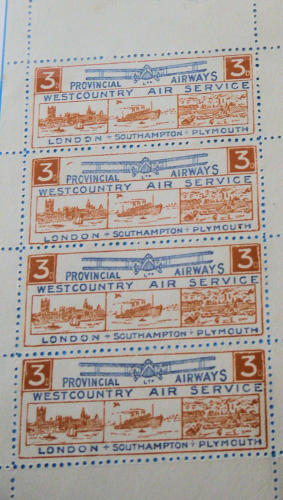
Second Printing
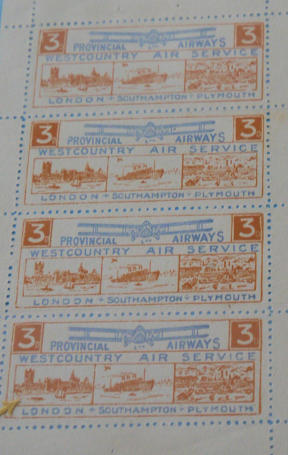
Orange and blue. When the steroes were put together for
this printing they were in a different order to that of the
first printing. Tug without funnel is now number 4 whereas
it was number two in the first printing.
Third Printing
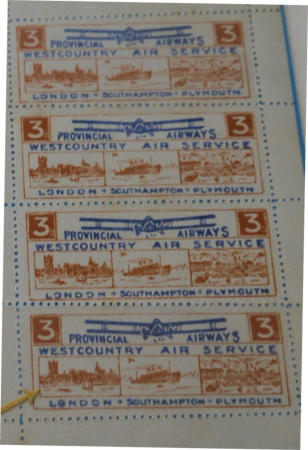
Orange and dark blue steroes in same order as second
printing. Wings of plane almost solid colour. The orange
varies a little in shade.
Fourth Printing

Dark orange and blue, smudgy in appearance due to plate wear
on the stereos. ‘D’ in the value tablets almost worn away.
Stereos in the same order as the second and third printing.
Fifth Printing
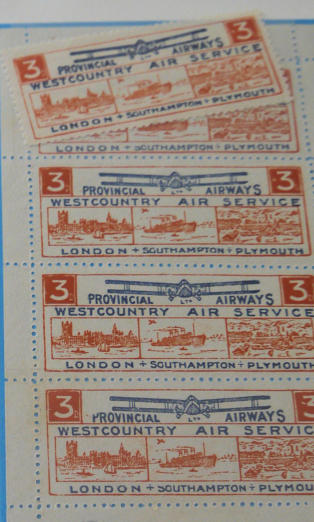
Colour Trials
Colour trials in blue green and brown, printed on different colour papers. These were most likely taken from the original Papier Mache moulds.

Proofs
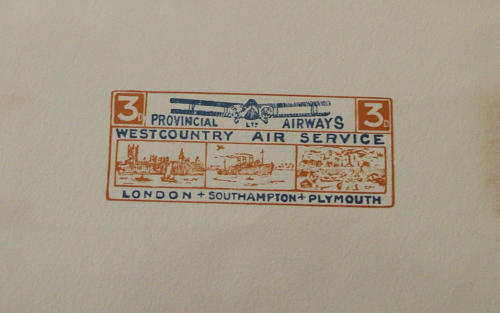
Proof on thin card from a mock-up block. Notice the
screw mark on the right-hand side of the wing. Also,
the distorted frame at bottom left and the major screw
mark at the side of the ocean liner.

Proof on thin glazed paper taken from the Artists
drawing. Note how the angle of shading in the upper
right wing differs from the issued labels.

British Internal Airmails of the 1930’s
Reddish Orange & Light Blue. Marginal edge at the
bottom of sheet is deeper in this printing than in later
ones. 2nd stamp shows orange fleck near wings of plane
in top LH corner, caused by a badly placed screw. The
Tug in the Thames is without a funnel. After this 1st
printing the plate was broken up.



Provincial Airways - The 3d Air Label
Copyright
© 2020 Robert Farquharson All Rights Reserved
Provincial AIirways was inaugarated on the 10th October 1933. They didn’t start their scheduled service until the 19th March
1934 when they flew from Croydon to Plymouth. The service was extended to Penzance and in 1935 furhter stops were added
when they went as far as Nottingham and Hull. The extra routes didn’t help profitability and they flew their last flight on 23rd
September 1935.
The mail carrying service of Provincial Airways has been largely misundertood since they first flew mail on the 25th and 26th
November 1933. It was generally thought they ran a scheduled service with mail and that was stopped after the 26th by the
Postmaster General for breaking his monopoly. This was not the case. They did not run a scheduled service until March 19th
1934. The mail flights of the 25th an 26th were purely a philatelic event provided to give first flight covers to the Philatelic
market. When the scheduled serrvice started they had six-seater DH 80 and 83’s. The mail flight was flown with a 2 seater
DH60.The postmaster General did not stop the flights and he did not get invloved until December 22nd 1933. See the letters
section for full deatils.
The 3d air label
Special 3d stamps were issued. Five printings were made. The first 4 printings have various errors. The funnel missing on the tug is in all 4 printings but only one stamp of the sheet. The different printings have different errors and colours and can be identified. The first 4 printings were all recorded as flown. The 5th printing corrects the errors but was done after the flights stopped after the Postmaster General forbade further carry of mails, so there are none flown. There were two different cancels. The first has the town in the centre of the oval, the second the date only. There are two cachets, the most common being ‘FIRST FLIGHT’, the second being ‘West of England Air Service’. While there were 16 variations of stamps the one of most interest to collectors is the ‘missing funnel’ flaw. This occurs in all four printings but only once on each sheet. A detailed study of the label can be found in the Articles section titled ‘The Provincial Airways 3d label. An in depth study.’ These vignettes were issued on the 20th Oct. 1933, without the sanction of the Postmaster General. The two dies (one for the orange part and the other for the blue) were produced by the Plymouth Process Engraving Co. Papier Mache moulds were taken from these. Messer’s Clarke Doble & Co Ltd., Plymouth made the ordinary stereos from these moulds, which were mounted on blocks of wood and formed the actual printing plates. A full sheet consisted of 4 stamps. These sheets were stapled together to form pads of 100 sheets. In all five separate printings were produced.First Printing

Second Printing

Orange and blue. When the steroes were put together for
this printing they were in a different order to that of the
first printing. Tug without funnel is now number 4 whereas
it was number two in the first printing.
Third Printing

Orange and dark blue steroes in same order as second
printing. Wings of plane almost solid colour. The orange
varies a little in shade.
Fourth Printing

Dark orange and blue, smudgy in appearance due to plate wear
on the stereos. ‘D’ in the value tablets almost worn away.
Stereos in the same order as the second and third printing.
Fifth Printing

Colour Trials
Colour trials in blue green and brown, printed on different colour papers. These were most likely taken from the original Papier Mache moulds.
Proofs


British Internal Airmails of the 1930’s
Reddish Orange & Light Blue. Marginal edge at the
bottom of sheet is deeper in this printing than in later
ones. 2nd stamp shows orange fleck near wings of plane
in top LH corner, caused by a badly placed screw. The
Tug in the Thames is without a funnel. After this 1st
printing the plate was broken up.













































